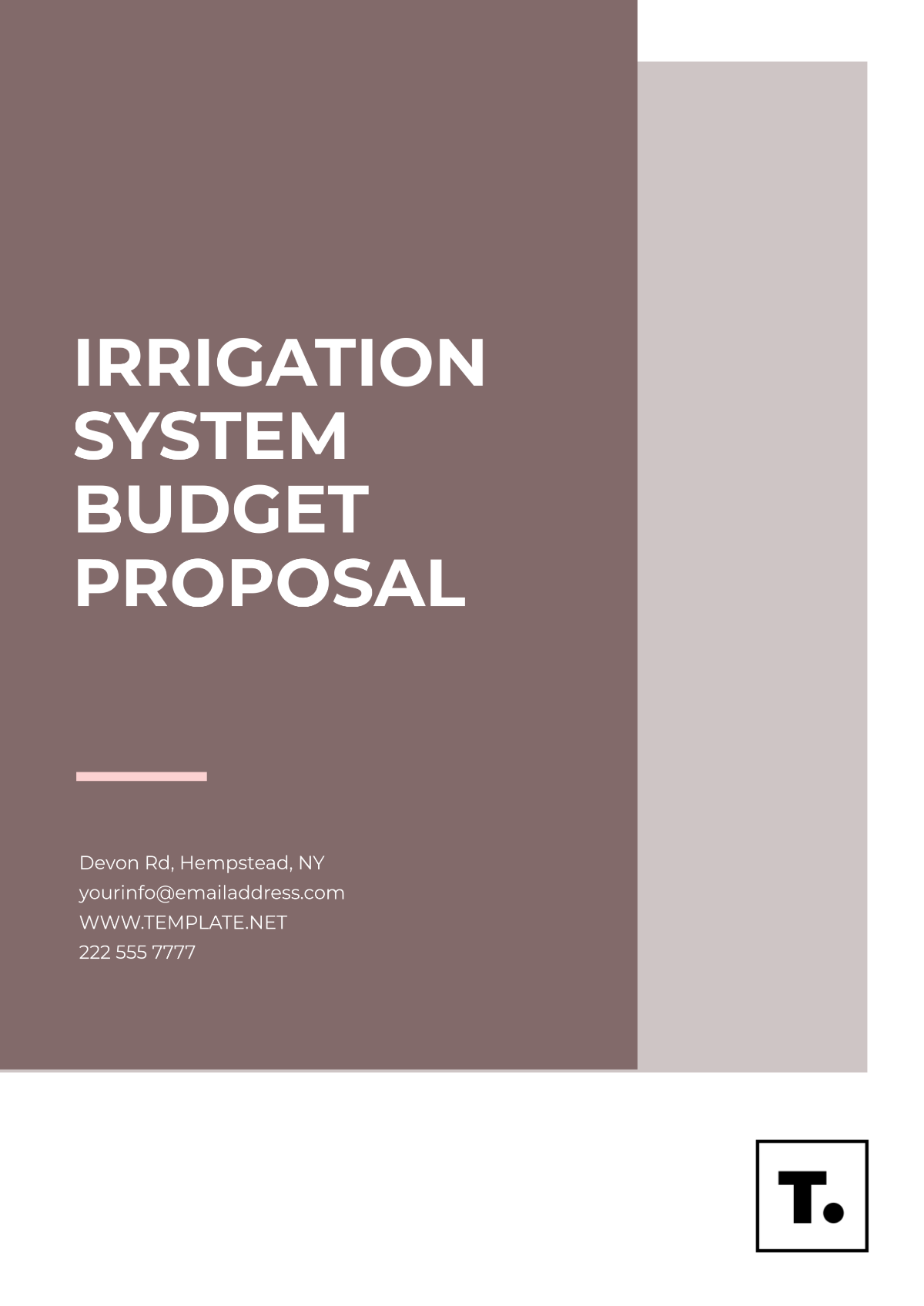Free Agricultural Development Project Proposal Template
Agricultural Development Project Proposal
I. Introduction
Agriculture serves as the cornerstone of local economies worldwide, yet outdated practices often hinder its full potential. Our proposed Agricultural Development Project is poised to revolutionize traditional farming methods by integrating cutting-edge technologies and sustainable techniques. Through the implementation of precision agriculture systems, state-of-the-art irrigation methods, and a commitment to organic farming principles, our initiative aims to not only boost agricultural productivity but also enhance environmental sustainability. By embracing these innovations, we seek to meet the increasing consumer preference for nutritious, pesticide-free crops while ensuring long-term viability and profitability for local farmers.
This project represents a strategic investment in the future of agriculture, promising to deliver tangible benefits such as improved crop resilience, optimized resource management, and enhanced profitability. By fostering a community-wide adoption of these modern practices, we envision a vibrant agricultural sector capable of meeting growing food demands sustainably. Our proposal underscores our commitment to innovation, sustainability, and community prosperity, positioning [Your Company Name] at the forefront of agricultural advancement while contributing positively to local economies and environmental stewardship.
II. Project Goals
The primary goals of the Agricultural Development Project are as follows:
Increase Crop Yields through Precision Agriculture Techniques: Utilize cutting-edge technologies such as drones, satellite imagery, and soil sensors to precisely monitor and manage crop health and growth conditions. Implement data-driven insights to optimize planting patterns, nutrient application, and pest control strategies, ultimately maximizing yield per acre.
Optimize Water Usage with Advanced Irrigation Systems: Introduce efficient irrigation solutions like drip irrigation and smart irrigation controllers. These systems will minimize water wastage by delivering precise amounts of water directly to the roots of crops based on real-time weather and soil moisture data, ensuring optimal hydration while conserving water resources.
Promote Organic Farming Practices: Encourage the adoption of organic farming methods that prioritize soil health, biodiversity, and natural pest management. Provide training and support to farmers on composting, crop rotation, and integrated pest management (IPM) techniques, aiming to reduce reliance on synthetic chemicals and enhance the quality and marketability of produce.
Educate Local Farmers: Develop comprehensive training programs and workshops tailored to equip farmers with the latest agricultural knowledge and skills. Cover topics such as sustainable farming practices, financial management, and market trends to empower farmers to make informed decisions that enhance productivity and profitability.
Foster Economic Growth and Sustainability in the Region: Strengthen the local agricultural economy by creating jobs, increasing farm incomes, and expanding market opportunities for locally produced organic products. Promote collaboration among farmers, government agencies, and private stakeholders to build a resilient agricultural sector that contributes to long-term economic stability and environmental stewardship.
By achieving these goals, [Your Company Name] aims to establish a model of sustainable agriculture that not only enhances productivity and profitability but also promotes environmental sustainability and community resilience in the region.
III. Precision Agriculture Techniques
Precision agriculture involves utilizing advanced technologies to monitor and manage field variability in crops. By implementing these techniques, we aim to:
Techniques | Description | Benefits |
|---|---|---|
Crop Monitoring | Utilize remote sensing technologies, such as drones and satellites, to gather real-time data on crop health, growth patterns, and potential stress factors. | Enables early detection of pests, diseases, and nutrient deficiencies. Provides insights into crop growth stages and uniformity. Facilitates precision management of field variability. |
Integrate Geographic Information System (GIS) mapping to analyze field variability and optimize planting and management strategies. | Enhances spatial analysis for precise decision-making. Enables accurate mapping of soil types, elevation, and drainage patterns. Supports customized treatment of specific field areas. | |
Soil Sensors | Deploy advanced soil sensors to monitor moisture levels, nutrient content, pH balance, and temperature throughout the growing season. | Facilitates precise irrigation management based on real-time soil moisture data. Optimizes nutrient application to meet crop requirements. Helps in maintaining optimal soil health conditions. |
Utilize data from soil sensors to adjust irrigation schedules, nutrient application rates, and soil management practices in real time. | Reduces water usage by delivering water directly to plants when and where needed. Minimizes nutrient leaching and runoff, preserving water quality. Supports sustainable soil fertility management. | |
Data-Driven Decision Making | Implement precision agriculture software and analytics to interpret data collected from crop and soil monitoring technologies. | Enables predictive modeling for yield forecasting and risk assessment. Supports informed decisions on inputs such as seeds, fertilizers, and pesticides. Enhances overall farm operational efficiency. |
Utilize predictive modeling to make informed decisions regarding planting, fertilization, pest control, and harvesting schedules. | Improves resource allocation by optimizing timing and application rates of inputs. Enhances crop quality and yield consistency. Reduces production costs through targeted and efficient practices. | |
Variable Rate Technology (VRT) | Utilize VRT systems to apply inputs (fertilizers, pesticides) at varying rates across a field based on real-time data. | Improves efficiency by matching input application rates to specific crop and soil needs. Reduces input costs and minimizes environmental impact through targeted application. Enhances overall yield and quality of crops. |
Implement prescription mapping to create customized application plans tailored to field variability and crop requirements. | Enhances precision in input application by adjusting rates according to soil fertility and crop growth stages. Maximizes resource use efficiency and minimizes wastage. Supports sustainable farming practices and profitability. |
By integrating these advanced precision agriculture techniques, [Your Company Name] aims to empower farmers with actionable insights and tools to maximize productivity, optimize resource efficiency, and foster sustainable agricultural practices. These technologies not only enhance crop yields and profitability but also contribute to environmental conservation by minimizing inputs and improving soil health over the long term.
IV. Advanced Irrigation Systems
Effective water management is crucial for sustainable agriculture. Our project will introduce advanced irrigation systems designed to:
Systems | Description | Benefits |
|---|---|---|
Optimize Water Usage | Introduce advanced irrigation systems aimed at maximizing water efficiency and minimizing wastage. | Reduces water usage by delivering precise amounts of water directly to plants, minimizing evaporation and runoff. Enhances crop health and yield stability through consistent hydration. Supports sustainable water management practices. |
Drip Irrigation Systems | Implement drip irrigation systems that deliver water directly to the root zone of plants through a network of tubes and emitters. | Optimizes nutrient uptake and water distribution, promoting healthier root systems and improved crop growth. Reduces weed growth and disease risk by limiting moisture on foliage. Enhances overall farm productivity and water savings. |
Sprinkler Irrigation Systems | Utilize sprinkler irrigation systems that distribute water through overhead sprays or rotating nozzles, covering larger areas efficiently. | Ensures uniform water distribution across fields, suitable for a variety of crops and terrain types. Facilitates cooling of crops during hot periods, reducing heat stress. Enhances flexibility in irrigation scheduling and operation. |
Automated Irrigation Scheduling | Implement automated irrigation scheduling based on real-time data inputs such as soil moisture levels, weather forecasts, and crop water requirements. | Enhances precision in water application by adjusting irrigation timing and duration according to specific crop needs and environmental conditions. Reduces labor costs and manual oversight while optimizing water use efficiency. Supports sustainable farming practices and resource conservation. |
By introducing these advanced irrigation systems, [Your Company Name] aims to revolutionize water management practices in agriculture, ensuring efficient use of resources while enhancing crop productivity and resilience. These technologies not only minimize environmental impact but also contribute to long-term sustainability and profitability for local farmers.
V. Promotion of Organic Farming
There is a growing market demand for organic, pesticide-free produce. Our project will promote organic farming practices by:
Practices | Description | Benefits |
|---|---|---|
Natural Pest Control Methods | Introduce integrated pest management (IPM) techniques that rely on natural predators, crop rotation, and physical barriers to control pests organically. | Minimizes reliance on synthetic pesticides, reducing chemical residues in produce and promoting ecosystem health. Enhances biodiversity and natural balance in agroecosystems. Improves long-term pest management and crop resilience. |
Use of Organic Fertilizers | Promote the use of compost, manure, and other organic materials to enrich soil fertility and enhance nutrient availability for crops. | Builds soil structure and enhances water retention capacity, improving overall soil health and productivity. Reduces environmental pollution and runoff of chemical fertilizers into water sources. Enhances crop quality and marketability of organic produce. |
Training on Organic Certification | Provide comprehensive training and support to farmers on organic farming principles, certification standards, and documentation requirements. | Empowers farmers to meet regulatory standards for organic certification, expanding market opportunities for organic produce. Builds farmer capacity in sustainable agricultural practices and compliance with organic regulations. Supports consumer trust and premium pricing for certified organic products. |
By promoting these organic farming practices, [Your Company Name] aims to meet the increasing consumer demand for organic, pesticide-free produce while fostering environmental sustainability and farmer profitability. These initiatives not only improve soil health and crop quality but also contribute to the preservation of biodiversity and long-term agricultural resilience.
VI. Community Engagement and Education
Educating local farmers is essential for the success of this project. We will engage the community by:
Activities | Description | Benefits |
|---|---|---|
Workshops and Training Sessions | Organize regular workshops and training sessions to educate local farmers on modern agricultural practices, including precision farming and sustainable techniques. | Enhances farmer knowledge and skills in adopting innovative farming methods. Promotes continuous learning and adaptation to new technologies. Strengthens community cohesion and collaboration among farmers. |
Provide specialized training on financial management, marketing strategies, and business planning to support farm profitability and sustainability. | Equips farmers with essential business skills to improve financial viability and market competitiveness. Encourages strategic planning and diversification of income sources. Supports long-term economic stability and growth in rural communities. | |
Hands-on Demonstrations | Conduct practical demonstrations of new agricultural technologies, such as precision equipment and irrigation systems, in field settings. | Provides farmers with firsthand experience and confidence in using advanced farming tools. Illustrates benefits and practical applications of new technologies. Encourages adoption through direct observation and interaction. |
Facilitate interactive sessions on soil health management, crop rotation, and biodiversity conservation practices to enhance sustainability. | Promotes sustainable land stewardship and resilience against environmental challenges. Improves soil fertility and reduces dependence on external inputs. Enhances ecosystem health and biodiversity in agricultural landscapes. | |
Ongoing Support and Resources | Offer continuous support through access to expert advice, technical assistance, and informational resources on agricultural innovations and best practices. | Builds farmer capacity and confidence in implementing new techniques. Facilitates troubleshooting and problem-solving in adopting new technologies. Promotes sustained improvement in farm productivity and profitability. Supports long-term project success and community empowerment. |
Through these community engagement and education initiatives, [Your Company Name] aims to empower local farmers with the knowledge, skills, and resources necessary to enhance agricultural productivity, sustainability, and resilience. By fostering a culture of continuous learning and innovation, the project seeks to build a strong and self-reliant agricultural community capable of thriving in a rapidly evolving agricultural landscape.
VII. Economic and Environmental Impact
The implementation of this project will have both economic and environmental benefits, including:
Impact | Description | Benefits |
|---|---|---|
Economic Benefits | Enhance local economic growth by increasing crop yields and profitability through improved farming practices and enhanced market access. | Boosts farmer income and economic stability. Stimulates local economies through increased spending and investment. Creates job opportunities in agriculture and related sectors. |
Foster entrepreneurship and innovation in agriculture, supporting the development of value-added products and services. | Diversifies income sources and promotes economic resilience in rural communities. Encourages investment in agricultural infrastructure and technology. | |
Environmental Benefits | Reduce reliance on chemical fertilizers and pesticides through adoption of organic farming practices and integrated pest management (IPM) techniques. | Minimizes environmental pollution and contamination of soil and water resources. Enhances soil fertility and promotes natural ecosystem balance. |
Enhance soil health and biodiversity by improving soil structure, nutrient content, and beneficial microbial activity. | Supports sustainable land management and conservation practices. Preserves natural habitats and promotes biodiversity in agricultural landscapes. | |
Creation of Local Job Opportunities | Generate employment opportunities in farming, agribusiness, and support industries through project implementation and expansion. | Stimulates economic growth and reduces rural unemployment rates. Enhances livelihoods and standard of living in local communities. |
Promote skills development and capacity building among local workforce, fostering long-term career opportunities and professional growth. | Builds a skilled workforce capable of meeting evolving demands in agriculture and related sectors. Strengthens community resilience against economic fluctuations. | |
Conservation of Water Resources | Implement efficient irrigation systems and water management practices to conserve water resources and mitigate water scarcity risks. | Improves water use efficiency and reduces agricultural water footprint. Enhances drought resilience and ensures sustainable water supply for future generations. |
Promote responsible water stewardship and environmental sustainability through targeted conservation efforts and technological innovations. | Preserves freshwater ecosystems and supports aquatic biodiversity. Mitigates water pollution and promotes water quality improvement in local watersheds. |
The implementation of these economic and environmental strategies underpins [Your Company Name]'s commitment to fostering sustainable agricultural development. By balancing economic prosperity with environmental stewardship, the project aims to create lasting benefits for local communities, farmers, and ecosystems alike, ensuring a resilient and thriving agricultural sector for future generations.
VIII. Conclusion
Embracing sustainable technologies and innovative farming methods is pivotal in revolutionizing local agriculture, ensuring both food security and environmental stewardship. Our Agricultural Development Project marks a significant stride towards a future where farming is not only profitable but also sustainable. By fostering partnerships with local farmers and stakeholders, we envision a community-driven approach that empowers agricultural resilience and economic prosperity. Together, we aim to cultivate a landscape where productivity flourishes in harmony with natural ecosystems, paving the way for a resilient and thriving agricultural sector for generations to come.

















































